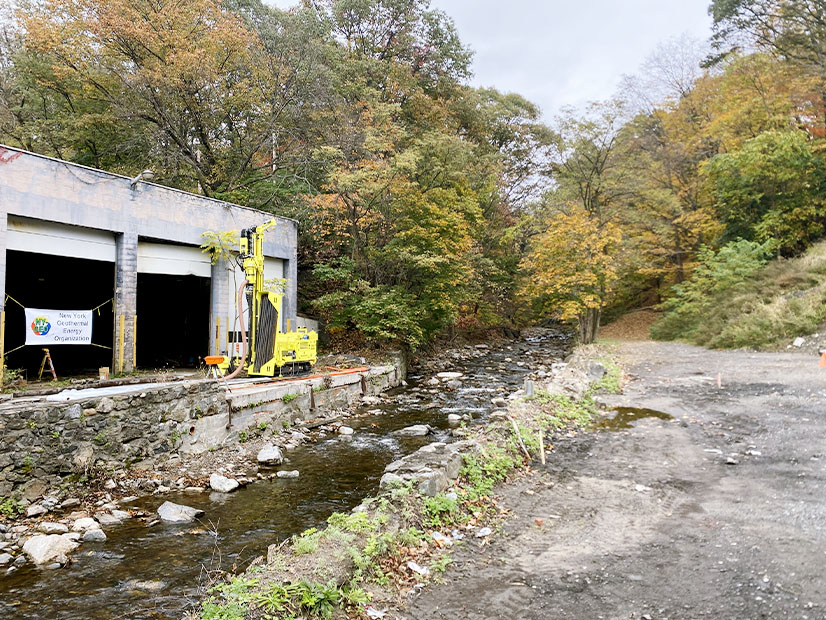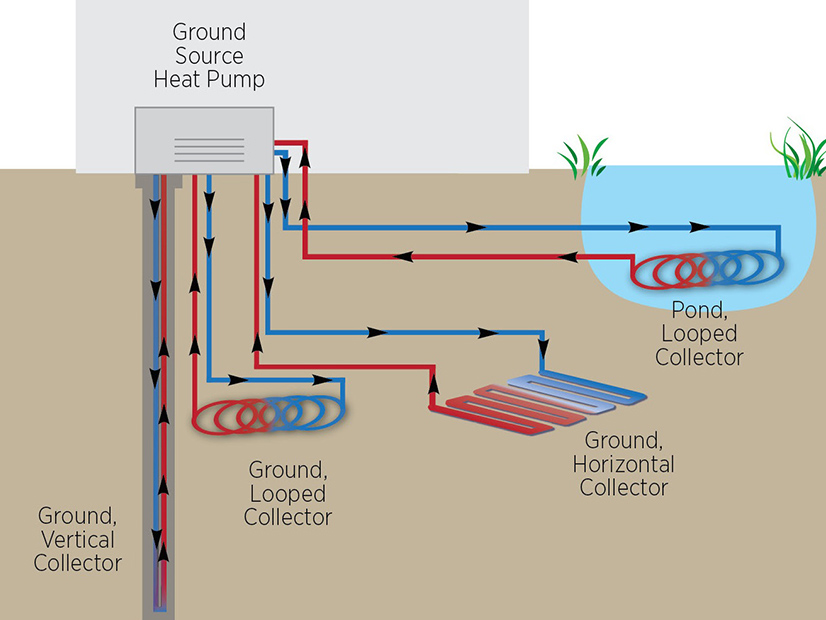
OSSINING, N.Y. — This Westchester County village will be the first place in the state to take advantage of a newly enacted law that expands the accessibility and affordability of geothermal energy.
Ossining is making geothermal energy the centerpiece of a mixed-used building on a 3.4-acre remediated brownfield site once used to turn coal into manufactured gas. The project will benefit from a law co-sponsored by Sen. Pete Harckham (D) (S6604) that exempts closed-loop geothermal boreholes from the state Oil, Gas and Solution Mining Law.
Before S6604, which Gov. Kathy Hochul (D) signed on Sept. 21, geothermal boreholes deeper than 500 feet were subject to the same regulations as oil and gas wells. The law’s proponents said the regulations added unnecessary costs and complexities to ground-source heat pump (GSHP) installations, which have little environmental impact because they do not involve injection into or extraction from the ground.
“We often make technical changes to laws in Albany, and people don’t necessarily see the tangible results, but today we have a very visible example of how one of those technical fixes is going to really revolutionize geothermal,” Harckham said at a Nov. 1 press conference at the site of the project, which will provide heating and cooling to 109 units in a mixed-use building that includes affordable housing. The project will be drilled by Dandelion Energy, a Northeast geothermal supplier, in partnership with the New York Geothermal Energy Organization (NY-GEO) and ZDF Geothermal.
Backers said the exemption from the mining law will cut costs, increase geothermal efficiency and make GSHPs possible in more places by limiting the footprint needed for drilling boreholes. The previous regulations applied on a per-well basis, adding costs and permitting barriers.
Heather Deese, senior director of policy and regulatory affairs at Dandelion, told NetZero Insider that S6604 “is one of the many steps needed to unlock the role that geothermal can play.” She said it allows Dandelion “to keep the cost of the drilling for a home geothermal installation as low as possible, because now we can drill one deeper hole for the ground-loop piping, rather than two shallower holes.”
Shallow systems also tend to underperform compared to their deeper projects that can tap higher sources of Earth heat.
“We can now use many more sites, particularly urban sites, and it will be much more cost effective,” said Harckham. “Before, drilling [a geothermal well] below 500 feet, all of the sudden, qualified you as an oil or gas well, and inherent with that were a host of financial obligations and permitting and reporting requirements. But now we will be able to take advantage of going beyond 500 feet for geothermal, opening up many, many more projects.”
Drilling Down
The sponsors project the legislation could reduce the cost of decarbonization by about $900 million by 2030 and another $9 billion between 2030 to 2050.
The Climate Leadership and Community Protection Act calls for a 40% reduction in building emissions by 2030 and the electrification of 85% of homes and commercial spaces by 2050. The Climate Action Council’s Scoping Plan, which laid out the roadmap to achieve CLCPA goals, says New York must install 250,000 electric heat pumps — including air- and ground-source units — annually to meet the mandates for 2030.
“Tapping into the potential of geothermal energy is critical to advancing New York’s transition to cleaner energy sources,” said Basil Seggos, commissioner of the Department of Environmental Conservation.
Tom Staudter, director of communications for Harckham, said that residential projects could save approximately $3,000 per job because they only need to drill one borehole versus several. For commercial buildings, he said the savings will be around $6 per square foot of floor space, if not more. He said the law will enable about 50% of commercial buildings to transition to geothermal systems; many previously were not able to transition because of cost concerns or a lack of space for multiple boreholes.
Staudter said many in the geothermal industry have been reaching out to Harckham’s office since the bill was signed. “They are ready to expand markedly because of the new law,” he said. “The transition to geothermal energy systems will increase exponentially, as more consumers and developers learn about capabilities, savings and ease of implementation.”
Installers say a geothermal heat pump for a 2,000-square foot home can cost between $15,000 and $38,000, double the price for a conventional HVAC system. They also estimate that drilling to install a GSHP costs about $5 to $40/foot. Total costs average between $4,000 to $8,000/ton installed. (One ton of refrigeration equals about 12,000 BTU/hour.)
Households switching from a fuel oil furnace to a geothermal system can save an average of 53% on their annual energy bill, or almost $1,900 a year, according to Dandelion.
Benefits & Barriers
Geothermal energy, one of the oldest forms of green power, dates back at least 10,000 years. Its first commercial usage was in Arkansas around 1830. The technology involves drilling vertical boreholes and inserting a closed-loop piping system filled with heat-conductive fluid that exchanges heat with the earth to either heat or cool a building.
Geothermal energy and GSHPs offer numerous environmental, health and economic advantages over fossil fuel systems, but high costs, geographic limitations and a shortage of skilled labor have thwarted widespread adoption.
The International Energy Agency says geothermal heat pumps have been growing at 3% per year in the U.S., with more than 1.7 million units installed. About 40% of installations are residential; the other 60% are commercial or institutional.
The U.S. also has about 3.7 GW of geothermal electric generating capacity, more than 90% of which is in California and Nevada. That represents less than 1% of U.S. capacity, but IEA says it could grow to more than 8% by 2050. Geothermal’s potential for direct use is 231 GW by 2050, including up to 17,500 district heating and cooling systems, according to the agency.
The 2022 Utility Thermal Energy Network and Jobs Act required the New York Public Service Commission to create regulatory frameworks for thermal energy networks and utilities to pilot at least one district or community-scale geothermal infrastructure project (S9422). The PSC issued guidance on this law in a September order, requiring utilities to submit their proposals by the end of this year. If approved, the projects will move on to engineering design and construction, with a target of being operational by 2025 (22-M-0429).
To encourage growth of the technology, New York offers a Geothermal Income Tax Credit that covers 25% of expenditures up to $5,000 for homeowners. The New York State Energy Research and Development Authority’s (NYSERDA) Clean Heat initiative offers rebates to incentivize the switch from fossil fuel-based systems (18-M-0084). Additionally, the state promotes the use of federal tax credits under the Inflation Reduction Act, which can cut installation costs by 30% through 2032, plus a 10% domestic content bonus, though these decrease in 2033 and 2034.
New York City offers an online feasibility tool to identify areas where ground source systems could be used to retrofit buildings’ heating and cooling systems. HeatSmart CNY offers assistance to building owners considering geothermal in Central New York.
Harckham said his goals for geothermal energy during the next legislative session is to “make it more accessible” by increasing state incentives.
Reactions
Reactions to S6604 have been overwhelmingly positive.
Sen. Mario Mattera (R), the ranking member of the Environmental Conservation Committee, praised Harckham for proposing S6604, saying, “This is a great bill. Me, being in the plumbing business, this is very, very important for renewable energy and for our future.”
In an interview with NetZero Insider, John Ciovacco, a board member at NY-GEO and president of Aztech Geothermal, said that New York’s actions will “simplify the conversion of buildings to these systems.”
“Having agencies like the [Department of Environmental Conservation] at the table opens us up to try and develop appropriate regulations and formulate ways to address everyone’s concerns,” Ciovacco said.
Pat McClellan, policy director at the New York League of Conservation Voters, described S6604 as “just another brick in the wall” to expand geothermal energy in the state, calling it a “common sense measure.”
McClellan emphasized that while New York has made significant strides in geothermal action, challenges like public awareness and long-term planning remain. State agencies and utilities “did an excellent job laying out ‘here’s where we are and here’s how we get there,’” he said, but there still is not enough attention paid to the 10-, 15- or 20-year time frames, “which is the time horizon we need to start think about in order to avoid future price shocks.”
Dandelion’s Deese said the state should consider raising its geothermal income tax credit to encourage consumer adoption. “More definitely needs to be done to raise awareness of geothermal,” she said, because many people have “not heard of geothermal heating and cooling before seeing a Dandelion advertisement.”
In response to questions from NetZero Insider, the DEC said it is assessing the best ways to communicate with stakeholders impacted by the new regulations, including by updating public websites and advising about best practices around these systems.
Michal Charles Moore, a visiting professor of economics and systems engineering at Cornell University, emphasized the importance of legislative recognition for geothermal energy. Cornell researchers last year drilled a 2-mile-deep exploratory Earth Source Heat borehole to demonstrate geothermal’s capabilities.
Moore said bills like S6604 are a “nod from the government” that stimulates additional research funding, collaboration and public trust.
“The industry just got a big boost,” Moore added. “They got acknowledged but are now on the hook to deliver.”


